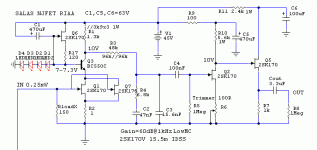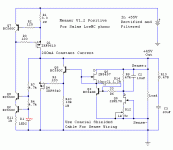Hey, very big thanks, Salas!
First question: the paralleled 2SK170 in the first stage are just for simulation purpose, isn't it?
Or are you really recommending,to parallel two SK170V in the first stage? Increasing the input capacitance and distortion?
Second question:
Did I miss a mod concerning C1? Not in parallel to the LED's? From gate to drain?
Franz
First question: the paralleled 2SK170 in the first stage are just for simulation purpose, isn't it?
Or are you really recommending,to parallel two SK170V in the first stage? Increasing the input capacitance and distortion?
Second question:
Did I miss a mod concerning C1? Not in parallel to the LED's? From gate to drain?
Franz
Last edited:
No. They are actually two for better noise since this is LowMC. No problem with capacitance with a 14R Z MC as DL103R. Linearity no problem in such super low swing. There are even 4x JFET many examples like the Ono. Anyway, its cascoded. C1 is actually from cascode base to B+. Better PSRR when not associated with ground. In your practical build you can try it even from base (+) to ground and judge hum.
Thanks Salas
Of course, you are right! With the low Z of the R103R capacitance is not a problem.
I will try this circuit. First step with a simple LM317 power supply, so I have the chance to compare it later with the Salas shunt regulated psu.
I will keep you informed about my steps. This weekend, I plan to make my own pcb for this preamp.
Kind regards
Franz
Of course, you are right! With the low Z of the R103R capacitance is not a problem.
I will try this circuit. First step with a simple LM317 power supply, so I have the chance to compare it later with the Salas shunt regulated psu.
I will keep you informed about my steps. This weekend, I plan to make my own pcb for this preamp.
Kind regards
Franz
Thanks Salas
Of course, you are right! With the low Z of the R103R capacitance is not a problem.
I will try this circuit. First step with a simple LM317 power supply, so I have the chance to compare it later with the Salas shunt regulated psu.
I will keep you informed about my steps. This weekend, I plan to make my own pcb for this preamp.
Kind regards
Franz
Good lucky & welcome to the Salas Simplistic NJFET RIAA club.
Tweaking RIAA
After all this time tweaking the RIAA components I agree with Salas advice that it's better for C3 don't arrive till the 16nF, if you use 16nF high frecuencies suffer & the sound is made blots, not focused without vigor; C2 with less of 16nF the sound is more life, fast, real, dynamic. It's really unbeliable what can do changing the value in a critical component of the RIAA, congratulations Salas for your knowledge & to share with us, another:



After all this time tweaking the RIAA components I agree with Salas advice that it's better for C3 don't arrive till the 16nF, if you use 16nF high frecuencies suffer & the sound is made blots, not focused without vigor; C2 with less of 16nF the sound is more life, fast, real, dynamic. It's really unbeliable what can do changing the value in a critical component of the RIAA, congratulations Salas for your knowledge & to share with us, another:




What about subjectively speaking?
Don't know, I have listened to both balanced and unbalanced components in several systems but the parameters are too many so to speak confidently. A fair thing would be to make the same CCT in both guises with same parts and live with it enough before commenting. Me I always follow economy. Due to I am not an engineer, I try to make simplest before I lose the ball so I go SE. I am pro useful, i.e. easy to make and fulfilling most of my subjective needs, not unconditionally best, I can't be sure I can design or control such anyway. J.Gerhard had made many experimental CCTs in the course of his MPP thread and maybe he can be more adequate for adding his comments on your SE VS Balanced query, if you ask there. He is good in describing subjectively too.
Uuuups, Salas
I made wrong measurements yesterday!
Most of my 2SK170V are showing between 12 to 13 mA IDDS. Second most between 11 and 12 mA and a few between 10 to 11 mA.
So, no IDDS of 15.5mA.
What happened?
I measured yesterday with the mA function of my DMM. But today, I attached a 1k resistor and measured the voltage along this resistor.
So, I trust this measurements today much more.
Could you please simulate the circuit with 12.5 mA?
Never trust your own measurements (in German: wer misst, misst Mist)
Sorry again!
Franz
I made wrong measurements yesterday!
Most of my 2SK170V are showing between 12 to 13 mA IDDS. Second most between 11 and 12 mA and a few between 10 to 11 mA.
So, no IDDS of 15.5mA.
What happened?
I measured yesterday with the mA function of my DMM. But today, I attached a 1k resistor and measured the voltage along this resistor.
So, I trust this measurements today much more.
Could you please simulate the circuit with 12.5 mA?
Never trust your own measurements (in German: wer misst, misst Mist)
Sorry again!
Franz
A little bit off topic, but maybe interesting for some of you for positioning this fine phono preamp:
I used a EMT930 with a "Tondose" TSD15, followed by Lundahl transformers and an Aikido Phono pre.
And I was very happy and never tried the Pacific concept.
I compared the EMT solution with my musicserver source. Very very nearby, both solutions. Sometimes I preferd vinyl, sometimes the musicserver.
Until I needed money. So, I could sell my EMT together with the trannies and the Aikido for a good price.
What followed?
This sales reactivated my activities concerning vinyl.
I needed a cheap solution for listening vinyl. So I could buy cheap a Thorens TD160 and revised it completely. And mounted my DL103R. And adjusted everything.
Then I attached my phonoclone preamp.
The musicserver was still better, in every case.
I fiddled also around with some other MC (Technics 300MC) and MM (Shure M75 and Shure V15/III) pickups and a VSPS instead of the phonoclone.
The musicserver was still better, in every case.
Then, I began to reactivate my Pacific board, never used before.
Boahh, emotions, fascination! Not enough gain, of course, for the DL103R. So, I attached two Studer 1:6 trannies in front of the Pacific.
Great!
I have now at least the quality back, I had with my EMT solution, but for a fraction of the money...
Only difference: with the EMT solution, I could track up to 100u horizontal amplitude, with the Thorens/DL103R I reach 80u, what is still enough.
I am looking forward, to use the two stage concept of the simplistic (is it really simplistic?) pre without step up trannies.
Franz
I used a EMT930 with a "Tondose" TSD15, followed by Lundahl transformers and an Aikido Phono pre.
And I was very happy and never tried the Pacific concept.
I compared the EMT solution with my musicserver source. Very very nearby, both solutions. Sometimes I preferd vinyl, sometimes the musicserver.
Until I needed money. So, I could sell my EMT together with the trannies and the Aikido for a good price.
What followed?
This sales reactivated my activities concerning vinyl.
I needed a cheap solution for listening vinyl. So I could buy cheap a Thorens TD160 and revised it completely. And mounted my DL103R. And adjusted everything.
Then I attached my phonoclone preamp.
The musicserver was still better, in every case.
I fiddled also around with some other MC (Technics 300MC) and MM (Shure M75 and Shure V15/III) pickups and a VSPS instead of the phonoclone.
The musicserver was still better, in every case.
Then, I began to reactivate my Pacific board, never used before.
Boahh, emotions, fascination! Not enough gain, of course, for the DL103R. So, I attached two Studer 1:6 trannies in front of the Pacific.
Great!
I have now at least the quality back, I had with my EMT solution, but for a fraction of the money...
Only difference: with the EMT solution, I could track up to 100u horizontal amplitude, with the Thorens/DL103R I reach 80u, what is still enough.
I am looking forward, to use the two stage concept of the simplistic (is it really simplistic?) pre without step up trannies.
Franz
Last edited:
Hmmmm, you are right, LM317 is limited to 37V.
Not a problem right now. I will build first the simplistic amp, then the psu.
Maybe I skip the LM317 solution and go direct to a shunt regulated supply...
Have a nice evening!
Franz
P.S.
At the moment listening Les McCann, Talk to the people. A great record!
Not a problem right now. I will build first the simplistic amp, then the psu.
Maybe I skip the LM317 solution and go direct to a shunt regulated supply...
An externally hosted image should be here but it was not working when we last tested it.
Have a nice evening!
Franz
P.S.
At the moment listening Les McCann, Talk to the people. A great record!
Maybe I skip the LM317 solution and go direct to a shunt regulated supply...
Nice photo, happy listening.
I highly recommend you go V1.2 remote sensing reg. You have seen the regs thread.
Attachments
- Home
- Source & Line
- Analogue Source
- Simplistic NJFET RIAA

